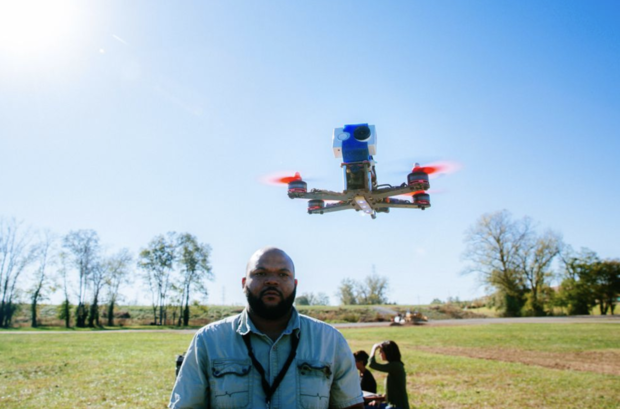Drone racing gets off the ground
Zoe Stumbaugh loves riding motorcycles — its exhilaration and sense of freedom. But she had to stop when a debilitating medical condition forced her to stay in bed for two years.
Even after Stumbaugh got back on her feet, her riding days were over. She was depressed and hoped a hobby would pull her out of her funk. That’s when she discovered drones.
Stumbaugh’s first drone was a quadcopter so tiny it fit in the palm of her hand. Then she bought a larger one and watched videos of people piloting them using first-person view (FPV) goggles. Just one month after buying her first unmanned flyer, Stumbaugh decided to build her own drone so she could get in on the action. It was September 2014.
It took her three months to construct one, and another couple of months to get good enough to enter a race. Despite her nerves, she won. Stumbaugh, now 26, has been called the world’s top female drone racer.
“It’s almost spiritual because you’re seeing something you physically can’t do, and that elevates your consciousness,” she says, describing the effect of piloting one of these things while looking through FPV goggles.
There’s also a nice jolt of adrenaline from steering through, over and around obstacles at more than 60 mph while seeing everything from the drone’s-eye view.
She’s not the only one who feels this way. In a startlingly short amount of time, a whole community — a whole industry, in fact — has cropped up around something that barely existed two years ago.
Enthusiasts enjoy everything about drone racing: building the drones, strapping on goggles that put them inside the cockpit, and hurtling through hoops and around hairpin turns while trying not to smash into anything. A quick search of Meetup shows more than 150 drone-racing enthusiast groups worldwide. Accomplished pilots compete in racing leagues and championships backed by big-name sponsors and watched by fans on the internet and ESPN.
Drone racing appears to be taking off.
Fly away drone
While small and regional racing leagues pop up all the time, Drone Sports Association and Drone Racing League have major league ambitions. Both have attracted sponsors, signed broadcasting deals with ESPN and hosted championship events paying big prize money.
DSA, where Stumbaugh competes, hosts the U.S. National Drone Racing Championships and the World Drone Racing Championships.
DRL has announced more than $21 million in funding, and has signed deals with ESPN as well as Sky and 7Sports in Europe. It also nabbed Bud Light as the title sponsor of the 2017 Bud Light DRL Tryouts, set up to find the next great FPV pilot. The champion gets a $75,000 professional contract and Bud Light sponsorship.
Bud Light isn’t the only big name to get behind drone racing. You’ll find brands like GoPro and Mountain Dew, not exactly strangers to the extreme sports realm, as well as insurance corporation AIG and accounting firm Ernst & Young. Nothing says adrenaline like spreadsheets.
“There’s something thrilling about watching very skilled people pilot a craft at tremendous speeds through a complex course,” says DRL founder Nick Horbaczewski, who describes the league as a cross between Formula One and esports.
DRL looks for interesting indoor locations such as abandoned malls, football stadiums, office buildings and even an old paper mill. Picture 12 pilots sending their drones — built and supplied by DRL — through and around neon-lit gates, flags and hairpin turns that some drones might not survive.
“If it crashes, it actually explodes into a thousand pieces,” Horbaczewski says.
Now there’s action a Nascar fan could love.
Getting off the ground
DRL is quick to differentiate itself from hobbyist groups, but hobbyist groups are where this all started.
I’m at a local park on a beautiful October day in Louisville, Kentucky, where Frank Mattingly, founder of the Derby City Drone Racing League, has rounded up six guys to show off their drones.
They’re happy to chat, happy to fly. Winston Francis Garthwaite talks me through the different parts of a drone — from motors to onboard camera — acting as human FAQ.
He tells me he got into drone racing after “falling down a rabbit hole called YouTube” two years before. His story is fairly typical of the way others (mostly men in their 20s and 30s) get into the sport. A motorcycle mechanic, he also likes the tinkering and fixing involved in drone racing.
Garthwaite counts down, and the drones rise off the ground and zoom off through gates, around trees and up into the cloudless sky. The buzz is unexpectedly loud.
For all the action, it’s weird to see pilots rigidly staring straight ahead through their FPV goggles. They’re watching the race from their drones’ perspective, but to me it looks they’re missing the show. But it makes sense — Stumbaugh says drone racing is a head game.
“You’re flying them with your thumbs, but really, it’s your brain that’s doing all the processing,” she says.
Most of these guys found each other through Meetup.
Garthwaite explains the culture like this: “You drive down the road, see some guy flying a drone and stop and say ‘hey.’” He estimates he flies three to four times a week for a few hours at a time.
“If I’m not working and there’s a nice sunset and the weather’s good, I’m out flying,” he says.
People use the word “addictive” a lot when they talk about drone racing. No wonder it’s grown so quickly.
Even my local Derby City Drone Racing has had its big moment. Mattingly founded the group for Mega Drone X, “the world’s first subterranean FPV race,” held last year at the epically named Mega Cavern in Louisville. The 100-acre former limestone mine offers storage facilities, underground ziplines and, at Christmas, a drivable, 30-minute route that’s decked out in 2 million lights.
Last spring, spectators watched dozens of drones rise up from black cubes to speed around an underground track lit with LED arrows, hoops and gates.
Joe Scully, who helped organize and design the event, says Mega Drone X is already a “major part of history” in the drone racing community. Rising costs, though, means there probably won’t be another one.
Flying through obstacles
While cash flow is a problem for any business starting out, leagues face a few extra challenges.
For one, no one’s quite cracked how to make it a spectator sport. With the naked eye, drones look like a bunch of gnats buzzing around. It’s hard to keep up with which drone is which and exactly what the standings are.
It’s why DRL uses larger drones fitted out in colorful LED lights. The league also uses a camera and cable system to capture the action, much like Formula One follows cars speeding down a straight section of the racetrack.
Plus there’s the fact that the races are short. How do you keep spectators entertained in between? Broadcasters usually fill time with featurettes and interviews, says Sally French, who covers drone technology for Marketwatch. If you’re watching in person, though, you have to make your own entertainment.
This is also an expensive sport to play in. It costs anywhere from $400 to $1,500 just to build a racing drone, not to mention what it takes to maintain and repair something that, as Horbaczewski puts it, can explode into “a thousand little pieces.”
Pass it on
Stumbaugh wants more people to know firsthand the joys of flying a drone.
Her hexinair.com website helps pilots find fly-ins and events near her home in Santa Cruz, California. An FAQ answers newbie questions and recommends drones, equipment and places to buy replacement parts. Links take users to her ZoeFPV YouTube channel, where they can watch drone-building instructions as well as drones in flight. She’s also developed one of the world’s smallest racing drones, called the Twitch 109, that bounces safely in a crash. You can buy it ready-made for about $370.
Over the years, Stumbaugh has heard pilots say racing makes them feel like a superhero soaring effortlessly in the sky. She uses words like power, speed and adrenaline. “It’s like riding a motorcycle again,” she says.
It’s different when she flies for fun. Without the pressure of competition, piloting feels like an out-of-body experience she can control. “You become hyperfocused on what you’re doing and the world melts away,” she says.
For those moments, she’s in the drone.
This story appears in the spring 2017 edition of CNET Magazine. For other magazine stories, click here.
Batteries Not Included: The CNET team shares experiences that remind us why tech stuff is cool.
It’s Complicated: This is dating in the age of apps. Having fun yet? These stories get to the heart of the matter.
This article originally appeared on CNET.





